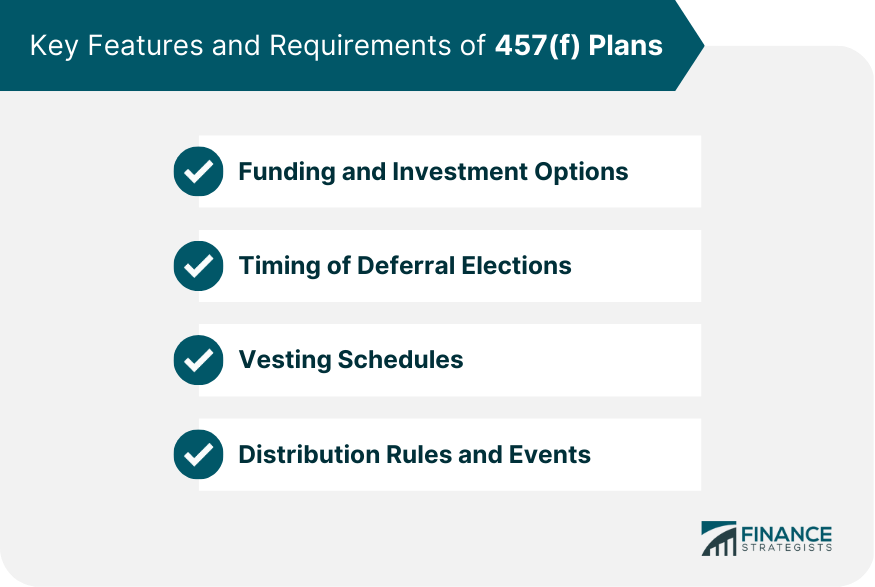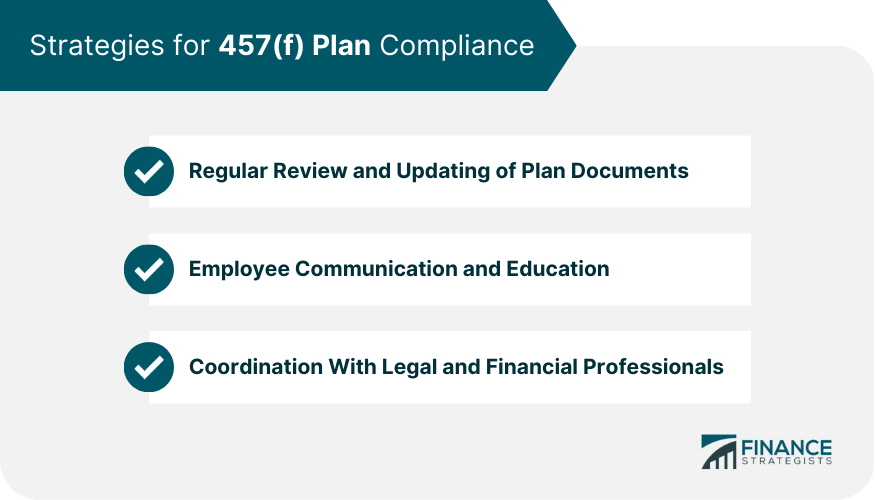What Is a 457(f) Plan?
A 457(f) plan is a nonqualified deferred compensation arrangement primarily used by tax-exempt organizations to provide additional retirement savings and deferred compensation for select executives and key employees.
These plans are subject to specific Internal Revenue Code (IRC) regulations and are distinct from 457(b) plans.
457(f) plans offer a flexible compensation arrangement that helps tax-exempt organizations attract, retain, and reward key employees. These plans provide tax deferral opportunities and can supplement other retirement savings plans.
While both 457(f) and 457(b) plans are designed for tax-exempt organizations, 457(f) plans have fewer restrictions on contribution limits and are generally available only to a select group of highly compensated employees.
Eligibility for 457(f) Plans
Types of Organizations That Can Establish 457(f) Plans
Tax-exempt organizations, such as nonprofits, public universities, and governmental entities, can establish 457(f) plans to provide deferred compensation for their key employees.
Employees Eligible to Participate in 457(f) Plans
Participation in a 457(f) plan is typically limited to a select group of highly compensated executives and other key employees. The organization determines eligibility based on its compensation strategy and plan documents.
Establishing a 457(f) Plan
Drafting Plan Documents
Organizations must draft plan documents that outline the terms and conditions of the 457(f) plan, including deferral elections, vesting schedules, and payment distributions. The plan documents must comply with relevant IRC regulations.
Implementing the Plan
Once the plan documents are finalized, the organization must implement the plan, enroll eligible employees, and establish procedures for deferral elections and payment distributions.
Compliance With Internal Revenue Code (IRC) Regulations
Organizations must ensure their 457(f) plans comply with all relevant IRC regulations to avoid potential penalties and adverse tax consequences for employees.
Key Features and Requirements of 457(f) Plans
Funding and Investment Options
457(f) plans can be funded through a variety of investment options, such as mutual funds, annuities, or life insurance policies. Investment earnings in the plan are generally tax-deferred until distribution.
Timing of Deferral Elections
Employees must make deferral elections before the beginning of the calendar year in which the compensation is earned or within a specific timeframe for performance-based compensation.
Vesting Schedules
Vesting schedules determine when employees gain a nonforfeitable right to the deferred compensation. The organization can establish its own vesting rules, which may include cliff vesting or graded vesting based on years of service or performance metrics.
Distribution Rules and Events
457(f) plans must specify the timing and events that trigger payment distributions, such as separation from service, a predetermined date, disability, or death.

Tax Implications of 457(f) Plans
Tax Treatment of Deferred Compensation
Under a 457(f) plan, deferred compensation is generally not subject to income tax until it vests and is paid to the employee. However, the investment earnings on the deferred amounts may be subject to taxation depending on the plan structure.
Constructive Receipt Doctrine
The constructive receipt doctrine is a tax principle that requires employees to recognize income when they have control or unrestricted access to the funds. To avoid constructive receipt, the 457(f) plan must include a substantial risk of forfeiture.
Reporting Requirements for Employers and Employees
Employers and employees must report deferred compensation under a 457(f) plan on their respective tax filings, such as Form W-2 for employees and Form 1099-MISC for independent contractors.
Strategies for 457(f) Plan Compliance
Regular Review and Updating of Plan Documents
Organizations should regularly review and update their 457(f) plan documents to ensure compliance with current IRC regulations and avoid potential penalties.
Employee Communication and Education
Clear communication and education about the 457(f) plan, including the benefits, requirements, and potential risks, are crucial for helping employees make informed decisions about their deferred compensation.
Coordination With Legal and Financial Professionals
Working with experienced legal and financial professionals can help organizations navigate the complex 457(f) plan regulations and maintain compliance with these deferred compensation arrangements.

Advantages and Disadvantages of 457(f) Plans
Benefits for Employers and Employees
457(f) plans offer several advantages, such as tax deferral, increased retirement savings, and the ability to attract and retain top talent. For employers, these plans can be an effective tool for motivating and rewarding key employees.
Potential Drawbacks and Risks
However, 457(f) plans also have some potential drawbacks, such as the risk of noncompliance with IRC regulations, the potential for employees to forfeit unvested amounts, and the administrative burden associated with plan management.
Comparing 457(f) Plans With Other Nonqualified Deferred Compensation Plans
409A Plans
409A plans are another type of nonqualified deferred compensation arrangement subject to specific IRC regulations.
While both 409A and 457(f) plans offer tax deferral opportunities, 409A plans are typically used by for-profit organizations, while 457(f) plans are designed for tax-exempt organizations.
457(b) Plans
457(b) plans are similar to 457(f) plans but have more restrictive contribution limits and are available to a broader range of employees within tax-exempt organizations. Unlike 457(f) plans, 457(b) plans do not require a substantial risk of forfeiture.
Other Types of Nonqualified Deferred Compensation Arrangements
Other nonqualified deferred compensation arrangements, such as phantom stock plans and stock appreciation rights (SARs), can provide employees with additional incentive-based compensation linked to the organization's performance or stock value.
Conclusion
Importance of 457(f) Plans for Deferred Compensation Arrangements
457(f) plans play a crucial role in managing deferred compensation arrangements for key employees in tax-exempt organizations, providing valuable tax deferral opportunities and helping organizations attract and retain top talent.
Key Considerations for Establishing and Maintaining a 457(f) Plan
Organizations must carefully consider the requirements and regulations governing 457(f) plans when establishing and maintaining these arrangements to avoid penalties and ensure favorable tax treatment for employees.
The Role of Legal and Financial Professionals in 457(f) Plan Compliance
Working with experienced legal and financial professionals is essential for navigating the complex 457(f) plan regulations and maintaining compliance with these critical deferred compensation arrangements.
457(f) Plan FAQs
A 457(f) plan is a type of deferred compensation plan that is used by certain tax-exempt organizations to provide retirement benefits to their executives.
A 457(f) plan differs from a 457(b) plan in that it is not subject to the same contribution limits and distribution rules. A 457(f) plan is also subject to additional tax and compliance requirements.
Only certain tax-exempt organizations, such as colleges and universities, hospitals, and charitable organizations, are allowed to offer a 457(f) plan.
Distributions from a 457(f) plan can only be made upon a specified triggering event, such as retirement, disability, or separation from service.
The taxation of a 457(f) plan depends on whether it is structured as a nonqualified deferred compensation plan or a traditional deferred compensation plan. Generally, nonqualified deferred compensation plans are subject to income tax when the benefits are no longer subject to a substantial risk of forfeiture.
True Tamplin is a published author, public speaker, CEO of UpDigital, and founder of Finance Strategists.
True is a Certified Educator in Personal Finance (CEPF®), author of The Handy Financial Ratios Guide, a member of the Society for Advancing Business Editing and Writing, contributes to his financial education site, Finance Strategists, and has spoken to various financial communities such as the CFA Institute, as well as university students like his Alma mater, Biola University, where he received a bachelor of science in business and data analytics.
To learn more about True, visit his personal website or view his author profiles on Amazon, Nasdaq and Forbes.











